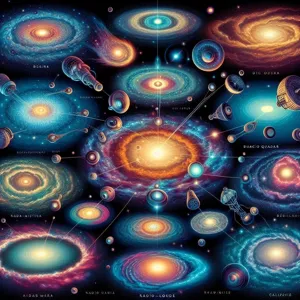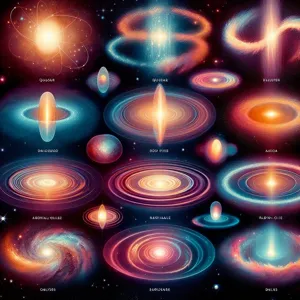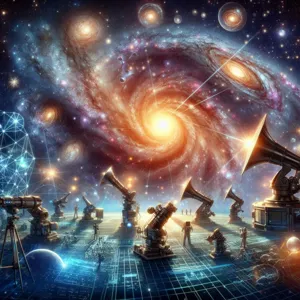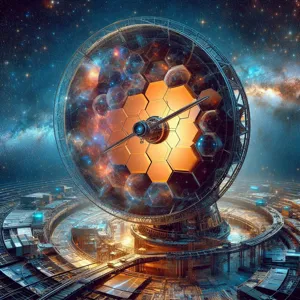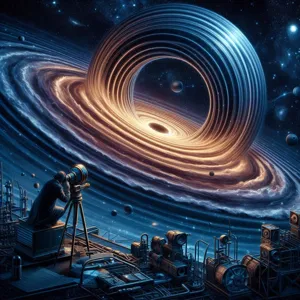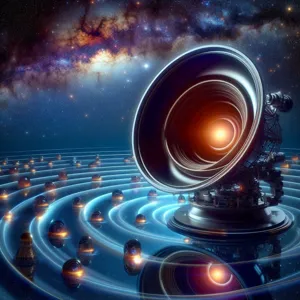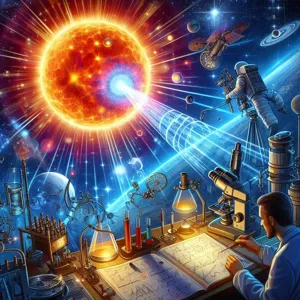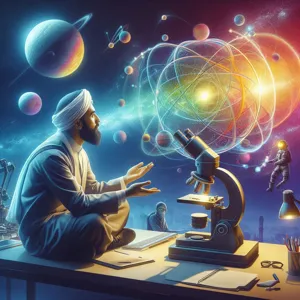The universe is a vast tapestry of celestial wonders, and among its most captivating elements are the stars that illuminate our night sky.
But have you ever wondered what these brilliant orbs are made of? The answer lies in the intricate work of astronomers who, through a combination of innovative technology and profound scientific principles, have unlocked the secrets of stellar composition. By analyzing the light emitted from these distant suns, astronomers can decipher their chemical makeup, revealing a wealth of information about their formation, lifecycle, and the fundamental processes that govern the cosmos. In this blog post, we will delve into the fascinating methods used to study the elements that make up stars, from spectroscopy to the study of stellar spectra, and explore how this knowledge not only deepens our understanding of the universe but also sheds light on the origins of the very elements that compose our own existence. Join us on a journey through the cosmos as we uncover the mysteries hidden within the stars.
1. Introduction to Stellar Chemistry

The vast expanse of the universe is not just a backdrop of twinkling lights; it is a rich tapestry woven from the intricate chemical compositions of countless stars. Each star, from our Sun to the most distant giants, acts as a cosmic laboratory, where elements are forged and transformed over billions of years. Understanding stellar chemistry is crucial for unraveling the mysteries of the universe, including the origins of the elements that make up our own planet and life itself.
At the heart of stellar chemistry lies the process of nucleosynthesis, where nuclear reactions in a star’s core fuse lighter elements into heavier ones, creating the diverse array of elements we see in the cosmos today. This process is responsible for producing everything from hydrogen and helium—the building blocks of stars—to heavier elements like carbon, oxygen, and iron, which are essential for life as we know it.
Astronomers use sophisticated techniques to decode the chemical fingerprints of stars. By analyzing the light emitted or absorbed by these celestial bodies, scientists can determine their composition, temperature, density, and even their age. This is achieved through spectroscopy, a method that dissects light into its component colors, revealing unique spectral lines that correspond to specific elements and molecules. Each element leaves a distinct mark on the spectrum, much like a signature, allowing astronomers to identify what a star is made of, even from billions of light-years away.
The study of stellar chemistry not only enhances our understanding of individual stars but also sheds light on the evolution of galaxies and the universe itself. It helps us piece together the cosmic history—how elements from ancient stars have been recycled over time, forming new stars, planets, and life. As we delve into the nuances of stellar chemistry, we unlock the secrets of the cosmos, gaining insight into the very fabric of our existence and the forces that shape the universe.
2. The Importance of Understanding Star Composition
Understanding the composition of stars is akin to unlocking the secrets of the universe, revealing not only the fundamental building blocks of celestial bodies but also the intricate processes that govern their formation, evolution, and eventual demise. Stars are the cosmic laboratories where elements are forged through nuclear fusion, and their chemical makeup provides invaluable insights into the origins of the universe and the life cycles of various astronomical phenomena.
By analyzing the light emitted from stars—specifically, the spectrum of that light—astronomers can identify the presence of different elements and compounds. This process, known as spectroscopy, allows scientists to determine a star’s temperature, mass, age, and even its distance from Earth. The spectral lines act as fingerprints, revealing the unique combinations of elements within a star, such as hydrogen, helium, carbon, and iron. Each element absorbs and emits light at characteristic wavelengths, enabling astronomers to piece together a star’s elemental puzzle.
Moreover, understanding star composition is crucial for several reasons. It helps us trace the evolutionary history of our galaxy and others, providing clues about how stars are born, how they evolve, and how they die. For instance, by studying the abundance of heavier elements in older stars, astronomers can infer the processes of stellar nucleosynthesis and the recycling of materials through supernova events.
Additionally, the chemical composition of stars influences the environments in which planets form. A star rich in heavy elements may be more likely to host a diverse array of planets, including those capable of supporting life. Thus, by unlocking the secrets of stellar composition, we not only learn about the stars themselves but also gather crucial information about the potential for life elsewhere in the cosmos.
In summary, unraveling the chemical makeup of stars serves as a cornerstone for understanding the universe’s broader narrative, connecting the dots between the creation of elements, the life cycles of stars, and the very existence of planetary systems. As we delve deeper into this cosmic tapestry, each discovery adds a new layer to our understanding of the universe and our place within it.
3. Basic Principles of Spectroscopy

At the heart of understanding the chemical composition of stars lies the fundamental technique of spectroscopy. This powerful method allows astronomers to unravel the mysteries of celestial bodies by analyzing the light they emit or absorb. But what exactly is spectroscopy, and how does it work?
Spectroscopy is founded on the principle that light is made up of different wavelengths, each corresponding to varying colors. When light from a star passes through a prism or a diffraction grating, it is dispersed into its constituent colors, creating a spectrum. This spectrum can be continuous, like a rainbow, or it can present as a series of distinct lines, known as an emission or absorption spectrum.
The key to decoding these spectra is understanding that each element emits or absorbs light at specific wavelengths, creating unique patterns of lines that act like fingerprints. For instance, hydrogen, the most abundant element in the universe, produces a distinct series of lines in the visible spectrum, while heavier elements such as iron and magnesium have their own unique signatures. By observing these lines and measuring their wavelengths, astronomers can identify which elements are present in a star and in what quantities.
Moreover, the Doppler effect plays an essential role in spectroscopy. As a star moves toward or away from Earth, the wavelengths of its emitted light are shifted—this is known as redshift and blueshift, respectively. By analyzing these shifts, astronomers can not only determine the composition of stars but also gain insights into their motion, distance, and even the expansion of the universe itself.
In essence, spectroscopy transforms the light from distant stars into a profound language of chemical elements, allowing astronomers to piece together the cosmic puzzle of our universe. This technique not only enhances our understanding of stellar life cycles but also reveals the origins of the very elements that make up everything we know.
4. How Light Reveals a Star’s Secrets
The light emitted by a star is akin to a cosmic fingerprint, uniquely revealing its chemical composition and physical properties. When we observe a star, we are not just seeing a distant point of light; we are witnessing an intricate dance of photons that carry with them a wealth of information. Each star emits light across a spectrum of wavelengths, and it’s within this spectrum that astronomers find the clues to unlock the star’s secrets.
As light travels from the star to our telescopes, it interacts with the elements present in the star’s atmosphere. This interaction generates distinct patterns known as absorption lines—specific wavelengths where light is absorbed by the elements. By analyzing these patterns, scientists can identify the presence of various chemical elements, such as hydrogen, helium, carbon, and iron, among others. Each element has its own unique set of absorption lines, much like a barcode, allowing astronomers to decode the star’s elemental makeup.
Moreover, the intensity and distribution of these absorption lines provide insights into the star’s temperature, density, and mass. For example, a star that appears to have strong hydrogen lines is likely to be in a different stage of its life cycle compared to one with prominent heavier element lines. This information helps astronomers not only understand the star itself but also its evolutionary history and the processes that have shaped it over millions of years.
Spectroscopy, the technique used to analyze the light from stars, has revolutionized our understanding of the universe. By utilizing sophisticated instruments like spectrographs, astronomers can capture a star’s light and break it down into its component wavelengths. This allows for a detailed analysis of the star’s chemical composition, temperature, and even its velocity through the Doppler effect, which reveals whether a star is moving toward or away from us.
In essence, the light of a star acts as a time capsule, preserving the history of its nuclear reactions and the materials from which it was formed. By studying this light, astronomers are not only unlocking the secrets of individual stars but also piecing together the grand narrative of the universe’s evolution, one luminous beacon at a time.
5. The Role of Telescopes in Stellar Observation

Telescopes are the indispensable tools of astronomers, allowing them to peer into the vastness of the universe and unlock the secrets of stellar composition. From the first rudimentary lenses used by Galileo to the advanced space-based observatories of today, the evolution of telescopic technology has been pivotal in expanding our understanding of the cosmos.
Modern telescopes operate on a variety of principles, each designed to capture different wavelengths of light emitted by stars. Optical telescopes gather visible light, revealing the beauty of celestial objects in stunning detail. However, to truly decipher the chemical makeup of stars, astronomers must also employ radio, infrared, and ultraviolet telescopes, each providing unique insights into the elements that compose celestial bodies.
For instance, infrared telescopes, like the renowned James Webb Space Telescope, are particularly adept at penetrating cosmic dust and gas, allowing astronomers to observe the formation of stars and the molecular clouds from which they emerge. By analyzing the light spectrum of a star, astronomers can identify specific absorption lines—fingerprints of elements such as hydrogen, helium, and heavier metals—providing a wealth of information about the star’s composition, temperature, and age.
Moreover, telescopes equipped with spectrometers play a crucial role in this process. By dispersing light into its constituent colors, these instruments allow scientists to study the spectral lines in detail. Each line corresponds to a specific element, enabling astronomers to determine not only what the star is made of but also its motion and distance from Earth.
In essence, telescopes are our cosmic eyes, bridging the gap between the terrestrial and the celestial. They empower astronomers to investigate the intricate dance of chemical elements within stars, unraveling the story of their birth, evolution, and eventual demise. As technology continues to advance, the capabilities of telescopes will only increase, promising even deeper insights into the chemical composition of the universe that surrounds us.
6. Analyzing Spectra: Identifying Elements in Stars
Analyzing spectra is a crucial technique that astronomers employ to unlock the secrets of a star’s chemical composition. When light from a star travels through space and reaches Earth, it carries with it a wealth of information encoded within its spectrum. By dispersing this light using a spectrograph, astronomers can break it down into its constituent colors, much like a prism reveals the rainbow hidden within sunlight.
Each element emits and absorbs light at specific wavelengths, creating distinct patterns known as spectral lines. These lines appear as dark or bright features against the backdrop of the continuous spectrum, resembling a unique fingerprint for each element. For instance, hydrogen, the most abundant element in the universe, showcases a series of characteristic lines, while heavier elements like iron and magnesium have their own distinct signatures.
By carefully analyzing these spectral lines, astronomers can determine not only which elements are present in a star but also their relative abundances and physical conditions, such as temperature and pressure. This process, known as spectroscopy, allows scientists to piece together the puzzle of stellar chemistry, revealing the intricate processes that occur within these distant celestial bodies.
The beauty of this method lies in its ability to transform light—a seemingly simple phenomenon—into a profound understanding of the universe. Each spectrum is a narrative of creation, evolution, and destruction, telling tales of stellar births in nebulae, the fiery fusion in a star’s core, and the eventual death throes of massive stars, enriching the cosmos with the very elements that make up our world. Through the lens of spectroscopic analysis, astronomers continue to deepen our knowledge of not just stars, but the very fabric of the universe itself.
7. The Hydrogen-Helium Connection: Stars and Their Birth
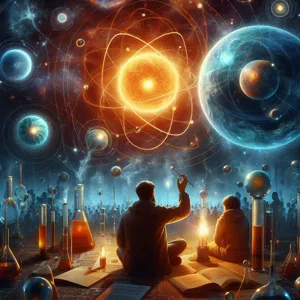
In the vast expanse of the universe, hydrogen and helium reign supreme as the most abundant elements, accounting for approximately 98% of the observable matter in stars. Understanding the intricate relationship between these two elements is key to unraveling the mysteries of stellar formation and evolution. Stars are born in cold, dense clouds of gas and dust, where gravitational forces pull hydrogen atoms together, creating clumps that eventually ignite into nuclear fusion. During this process, hydrogen is converted into helium, releasing immense amounts of energy that propel stars into their luminous existence.
The Hydrogen-Helium connection doesn’t just mark the birth of stars; it also plays a pivotal role in their lifecycle. As stars age, they exhaust their hydrogen fuel and begin to burn helium and other heavier elements, leading to a series of transformations. This transition not only alters the star’s brightness and temperature but also affects its eventual fate—whether it will expand into a red giant, shed its outer layers, or collapse into a white dwarf, neutron star, or black hole.
Astronomers employ a variety of techniques, including spectroscopy, to study the light emitted by stars and decipher their chemical compositions. By analyzing the specific wavelengths of light absorbed or emitted by hydrogen and helium, they can determine a star’s temperature, age, and even its distance from Earth. This method of decoding the cosmic symphony of elements provides invaluable insights into the lifecycle of stars and the evolution of galaxies.
As researchers continue to probe the depths of the universe, the Hydrogen-Helium connection remains a focal point in the quest to understand not only how stars form and evolve but also how they contribute to the chemical enrichment of the cosmos. The elements forged in the hearts of stars eventually find their way into planets, life, and the very fabric of the universe, underscoring the profound connection between these celestial bodies and the world we inhabit.
8. The Impact of Stellar Composition on Star Evolution
The chemical composition of a star plays a crucial role in its evolution, influencing everything from its birth to its ultimate fate in the cosmos. When a star forms, it gathers material from the surrounding interstellar medium, which is rich in hydrogen, helium, and trace amounts of heavier elements. This initial composition sets the stage for the star’s life cycle and can determine its mass, temperature, luminosity, and lifespan.
Stars primarily composed of hydrogen and helium will undergo nuclear fusion in their cores, a process that sustains them for billions of years. However, the presence of heavier elements, known as “metals” in astronomical terms, can significantly alter this process. These elements, which include carbon, oxygen, nitrogen, and iron, contribute to the cooling and heating of stellar matter, affecting the star’s internal dynamics and fusion reactions.
For example, a star with a higher metallicity—a greater abundance of these heavier elements—will tend to evolve more rapidly than its metal-poor counterparts. This is because metals enhance the opacity of the star’s outer layers, allowing for more efficient energy transfer. As a result, such stars can expand into red giants at an accelerated rate and may eventually explode in supernovae, enriching the surrounding space with their heavier elements. This cosmic recycling process is vital for the formation of new stars, planets, and ultimately, life as we know it.
Additionally, the differences in stellar composition can lead to the formation of diverse end states for stars. While low-mass stars may end their lives as peaceful white dwarfs, high-mass stars with high metallicity are more likely to undergo violent deaths, leaving behind neutron stars or black holes. Understanding these variations not only provides insights into the life cycles of individual stars but also helps astronomers piece together the broader narrative of galaxy evolution and the chemical enrichment of the universe.
In summary, the stellar composition is a key determinant of a star’s evolutionary path. By studying the chemical makeup of stars, astronomers can uncover the secrets of their past and predict their future, revealing the intricate dance of matter and energy that shapes the cosmos over eons.
9. Case Study: Analyzing a Specific Star’s Composition
To illustrate the intricate process of stellar composition analysis, let’s delve into a fascinating case study centered on the star HD 140283, affectionately known as the “Methuselah star.” This ancient star, located approximately 200,000 light-years away in the constellation Libra, has intrigued astronomers not just for its age—estimated to be around 13.7 billion years—but also for the unique insights it offers into the early universe’s chemical makeup.
The analysis of HD 140283’s composition began with high-resolution spectroscopy, a technique that breaks down light from the star into its constituent colors, revealing the presence of various elements based on their unique spectral lines. By capturing light through powerful telescopes, astronomers can detect these lines and identify the elements within the star’s atmosphere. In the case of HD 140283, researchers discovered an unexpectedly low abundance of metals, with only trace amounts of heavier elements like iron—contradicting the conventional understanding of stellar formation, where stars typically contain higher metal content.
This revelation prompted a deeper investigation into the star’s origins. Scientists proposed that HD 140283 might be one of the first stars formed after the Big Bang, composed primarily of hydrogen and helium, with only minimal contributions from subsequent supernova explosions. By using advanced models of nucleosynthesis, they could simulate the conditions of the early universe and trace the chemical evolution of stars over billions of years.
Moreover, stellar evolution models suggested that HD 140283 is nearing the end of its life cycle, providing a rare opportunity to study the processes that lead to its eventual demise. This star’s unique characteristics not only challenge existing theories but also enrich our understanding of the cosmos, revealing how the universe has transformed from a primordial state to the complex tapestry of stars and galaxies we see today.
Through the detailed analysis of stars like HD 140283, astronomers glean valuable information about the universe’s history and the fundamental processes that govern stellar formation and evolution. Each spectral reading brings us one step closer to unlocking the mysteries of the cosmos, allowing us to appreciate the intricate dance of elements that has shaped our universe over billions of years.
10. The Use of Chemical Abundances in Understanding Galactic Evolution
The study of chemical abundances within stars is a powerful tool in unraveling the mysteries of galactic evolution. By analyzing the elemental makeup of stars, astronomers can piece together the intricate history of galaxies, tracing their formation, growth, and eventual fate. Each star serves as a cosmic time capsule, holding clues about the conditions prevalent at the time of its formation.
When a star ignites, it begins a nuclear fusion process that synthesizes lighter elements into heavier ones. During its lifetime, a star will forge elements such as carbon, oxygen, and iron, which are then released into the interstellar medium upon its death, whether through a gentle shedding in the case of red giants or a spectacular supernova explosion for massive stars. These processes enrich the surrounding gas and dust, influencing the chemical composition of new stars that form in the same region.
By studying the ratios of various elements in a star’s spectrum, astronomers can infer the star’s age and the environment in which it was born. For instance, older stars tend to have lower metallicity — a term astronomers use to describe the abundance of elements heavier than helium — as they formed when the universe was younger and less enriched by previous generations of stars. In contrast, younger stars exhibit higher metallicity, reflecting the accumulation of elements produced by earlier stellar generations.
This understanding of chemical abundances not only aids in constructing a timeline of galactic evolution but also helps in identifying distinct stellar populations within galaxies. For example, the presence of certain elements can indicate whether a star belongs to the halo of a galaxy or the more chemically enriched disk. Moreover, examining the abundance patterns across different galaxies allows astronomers to make comparisons and assess the role of various processes, such as mergers and interactions, in shaping their evolution.
In essence, the study of chemical abundances is akin to reading the pages of a cosmic history book, where each star contributes a unique story about the past. As astronomers continue to refine their techniques and instruments, the insights gained from these chemical signatures will deepen our understanding of how galaxies, including our own Milky Way, have evolved over billions of years.
11. Challenges in Deciphering Stellar Chemistry
Deciphering the chemical composition of stars is no small feat; it comes with an array of challenges that astronomers must navigate. The vastness of space, combined with the extreme conditions of stellar environments, adds layers of complexity to this intricate puzzle. For starters, the immense distances between Earth and even the closest stars mean that astronomers often rely on light that has traveled for millions of years. This light carries a wealth of information, but it is also diluted and altered as it passes through interstellar mediums, introducing potential distortions that can obscure the true chemical signatures of celestial bodies.
Additionally, the intense heat and pressure within stars lead to unique physical states of matter that can affect the spectral lines astronomers use for analysis. Elements in a star may exist in highly ionized forms, shifting their spectral lines and complicating the identification process. This requires astronomers to have a deep understanding of atomic physics and to use advanced models to interpret the data accurately.
Moreover, the presence of various elements in a star can lead to overlapping spectral lines, a phenomenon known as line blending, which can further complicate analyses. To untangle this web of information, astronomers employ sophisticated techniques such as spectroscopy, where the light from a star is spread out into a spectrum, revealing the unique fingerprints of elements present. However, interpreting these spectra demands a keen eye and a wealth of experience, as even the slightest misinterpretation can lead to erroneous conclusions about a star’s composition.
Compounding these issues is the variability of certain stars. Many stars undergo changes over time, such as pulsations or eruptions, which can alter their chemical makeup and affect the spectra observed. This variability means that astronomers must not only take a snapshot of a star’s composition but also consider its dynamic nature to build an accurate model of its chemistry.
In essence, while the quest to understand stellar chemistry is a thrilling venture that unveils the secrets of the universe, it is fraught with obstacles that challenge even the most seasoned astronomers. Overcoming these hurdles requires a blend of innovative technology, theoretical knowledge, and a relentless curiosity about the cosmos.
12. Emerging Technologies in Astronomical Research
The realm of astronomical research is witnessing a remarkable transformation, thanks to the advent of emerging technologies that are revolutionizing the way astronomers study the cosmos. As we venture further into this new era, the integration of cutting-edge tools and methodologies is enhancing our ability to decipher the chemical composition of stars with unprecedented accuracy and efficiency.
One of the most exciting developments is the use of artificial intelligence and machine learning. These technologies are enabling astronomers to analyze vast datasets from telescopes and space missions at lightning speed. By training algorithms to recognize patterns in spectral data, researchers can automate the identification of elemental signatures within stellar atmospheres, significantly accelerating the pace of discovery.
Moreover, advancements in spectroscopy are playing a pivotal role in this field. Next-generation spectrographs, with their enhanced sensitivity and resolution, allow scientists to capture finer details of starlight. These tools can discern even the faintest chemical traces, revealing the intricate makeup of distant stars and providing insights into their formation and evolution. For instance, the recently developed ultra-high-resolution spectrographs are capable of detecting minute changes in the wavelengths of light emitted by stars, which directly correlate to the presence of specific elements.
Additionally, the deployment of space-based observatories, such as the James Webb Space Telescope, opens new frontiers in our understanding of stellar chemistry. These observatories can observe celestial objects beyond Earth’s atmospheric interference, allowing for clearer and more detailed observations. With their advanced imaging capabilities, astronomers can study the light from stars across vast distances, uncovering the secrets of their composition and the processes that shape them.
In essence, the future of astronomical research is bright, fueled by these emerging technologies. As we harness the power of AI, advanced spectroscopy, and space exploration, we are not only enhancing our knowledge of the universe but also unlocking new mysteries about the stars that have captivated humanity for centuries. The cosmos is becoming more accessible than ever, promising thrilling discoveries that will continue to expand our understanding of the universe and our place within it.
13. The Future of Stellar Composition Studies
As we stand on the brink of a new era in astronomy, the future of stellar composition studies promises to be as exhilarating as the discoveries of the past. With advancements in technology and a deeper understanding of the universe, astronomers are now equipped with tools that allow them to probe the very fabric of stars with an unprecedented level of detail. Innovations such as next-generation telescopes, like the James Webb Space Telescope, and sophisticated spectroscopic techniques will enable scientists to analyze the light from distant stars, revealing their chemical signatures with remarkable precision.
One of the most exciting prospects is the exploration of exoplanets—the planets orbiting stars beyond our own solar system. By studying the atmospheres of these distant worlds, astronomers can decipher not only the chemical makeup of the stars they orbit but also gain insights into the potential for life beyond Earth. As we enhance our capabilities to detect subtle spectral lines, we may uncover the presence of organic molecules and other indicators of habitability in these far-flung environments.
Moreover, the integration of artificial intelligence and machine learning in data analysis is revolutionizing how we interpret vast amounts of astronomical data. These technologies can identify patterns and anomalies that human researchers might miss, enabling a more nuanced understanding of stellar evolution and composition. This synergy between traditional observational techniques and modern computational methods opens the door to groundbreaking discoveries that could reshape our understanding of the cosmos.
As we look to the future, collaboration across disciplines—combining astrophysics, chemistry, and even computational sciences—will be crucial. This interdisciplinary approach will allow researchers to tackle complex questions about the origins of elements in the universe, the lifecycle of stars, and the cosmic processes that govern the formation of galaxies.
In essence, the future of stellar composition studies is a thrilling frontier filled with possibilities. With each new discovery, we are not only unlocking the secrets of individual stars but also piecing together the grand narrative of the universe itself—a narrative that continues to captivate our imagination and inspire generations of astronomers and enthusiasts alike.
14. Conclusion: The Broader Implications for Cosmology
In conclusion, the ongoing efforts of astronomers to decipher the chemical composition of stars extend far beyond mere curiosity; they are pivotal to our understanding of the universe as a whole. Each star we study acts as a cosmic time capsule, holding essential clues about the processes that shaped not only its own life cycle but also the evolution of galaxies, including our Milky Way. The intricate dance of nucleosynthesis within stars—where lighter elements fuse into heavier ones—reveals the fundamental mechanics of how matter in the universe is formed and transformed.
These revelations have profound implications for cosmology, as they help us trace the origins of the elements that compose everything we know, from the air we breathe to the planets we inhabit. By mapping the chemical fingerprints of stars across various galaxies, astronomers can uncover the history of the universe, including the Big Bang and subsequent cosmic events. This knowledge enhances our understanding of dark matter and dark energy, two of the universe’s most enigmatic forces.
Moreover, the advancements in spectroscopic techniques and observational technology are opening up new avenues for exploration. As we look deeper into the cosmos, we not only refine our theories regarding stellar evolution but also build a richer narrative about the interconnectedness of the universe. As we continue to unlock the secrets of the stars, we are steadily piecing together the grand puzzle of cosmological history, allowing us to appreciate the vastness of space and our humble place within it. The journey of discovery is far from over, and with each new finding, we inch closer to answering some of humanity’s most profound questions about existence and the universe’s ultimate fate.
15. Additional Resources for Aspiring Astronomers
For those captivated by the mysteries of the universe and eager to dive deeper into the field of astronomy, a wealth of resources is available to guide your journey. Whether you’re a budding stargazer or a serious student of astrophysics, these tools can enhance your understanding and appreciation of the cosmos.
**online Courses and Lectures:** Numerous platforms offer free or affordable online courses covering a wide array of topics in astronomy. Websites like Coursera, edX, and Khan Academy feature courses taught by university professors, allowing you to learn at your own pace. You might explore introductory classes in astrophysics or delve into specialized topics, such as stellar evolution or the chemistry of the universe.
**Books and Magazines:** The literary world is rich with titles that cater to all levels of interest. For beginners, “Astrophysics for People in a Hurry” by Neil deGrasse Tyson is a concise yet engaging overview. If you’re looking for something more technical, “An Introduction to Modern Astrophysics” by Andrew E. B. D. Carroll and Dale A. Ostlie serves as a comprehensive textbook. Additionally, magazines like “Sky & Telescope” and “Astronomy” provide current news, articles, and stunning astrophotography to keep you inspired and informed.
**Podcasts and YouTube Channels:** The auditory and visual mediums are invaluable for aspiring astronomers. Podcasts like “StarTalk Radio” and “The Infinite Monkey Cage” blend humor with scientific insight, making complex topics accessible. On YouTube, channels such as PBS Space Time and Frasier Cain’s “Universe Today” offer a plethora of videos that explain astronomical concepts, share the latest discoveries, and even provide tutorials on stargazing techniques.
**Local Astronomy Clubs and Observatories:** Engaging with like-minded enthusiasts can enrich your learning experience. Joining a local astronomy club allows you to participate in star parties, workshops, and lectures. Many clubs have access to telescopes and can offer hands-on experience with celestial observation. Additionally, visiting observatories can provide you with opportunities to view the night sky through powerful telescopes while learning from knowledgeable staff.
**Citizen Science Projects:** For those who want to contribute to real scientific research, consider participating in citizen science projects. Platforms like Zooniverse allow you to assist astronomers in analyzing data, whether it’s classifying galaxies or searching for exoplanets. This not only supports ongoing research but also gives you a firsthand look at how scientific discoveries are made.
By utilizing these resources, aspiring astronomers can expand their knowledge and passion for the cosmos. The universe is vast and full of wonders waiting to be discovered, and with the right tools and support, your journey into the stars can be both enriching and exhilarating.
As we conclude our exploration of how astronomers unlock the mysteries of the cosmos by deciphering the chemical composition of stars, it’s clear that this intricate process not only enhances our understanding of the universe but also reveals the fundamental building blocks of life itself. Through spectroscopy, data analysis, and innovative technologies, scientists can peer into the heart of these celestial giants, uncovering the elements that forged our existence. Each discovery adds another layer to our knowledge, painting a more complete picture of the universe’s evolution and our place within it. We encourage you to continue your journey of cosmic discovery—whether by stargazing, reading up on the latest astronomical findings, or simply pondering the wonders of the universe. The stars are not just distant points of light; they are the storytellers of our cosmic heritage, inviting us to explore and understand the vastness that surrounds us.

